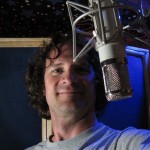 I had a great time doing an Interview with Bill DeWees. Check it out and look for more from Bill on his VoiceOverExpert You Tube Channel.
I had a great time doing an Interview with Bill DeWees. Check it out and look for more from Bill on his VoiceOverExpert You Tube Channel.
Thank you, Bill!
by Dan Friedman
 I had a great time doing an Interview with Bill DeWees. Check it out and look for more from Bill on his VoiceOverExpert You Tube Channel.
I had a great time doing an Interview with Bill DeWees. Check it out and look for more from Bill on his VoiceOverExpert You Tube Channel.
Thank you, Bill!
by Dan Friedman
 I live in what I think (and many will agree) is one of the most beautiful parts of the USA. However, all that lush forest and beautiful foliage brings with it pollen, allergens, and air so thick you can watch it as it blows by. For most people, allergy season is merely a nuisance. For voiceover talent, it can be frustrating, frightening and costly.
I live in what I think (and many will agree) is one of the most beautiful parts of the USA. However, all that lush forest and beautiful foliage brings with it pollen, allergens, and air so thick you can watch it as it blows by. For most people, allergy season is merely a nuisance. For voiceover talent, it can be frustrating, frightening and costly.
Learning to deal with allergies was never a concern for me until a few years ago. I never suffered from allergies until moving to the mountains and even then it took a few years before they took hold of me. Spring of 2010 was by far the most difficult season I’d ever had. I was unable to hear well and I definitely did not sound like myself. As someone who earns a living from having sharp hearing and a consistent vocal sound, this was definitely a problem. While I was able to work, I did not feel confident in what I was hearing and I did not like how I was sounding.
I used the neti pot three times a day. I ate locally produced honey. Before and during sessions, I ate spicy food, brought jalapeño peppers into the booth with me and put mentholatum ointment under my nose. I took anti inflammatory medication, OTC Phenq allergy and cold medicines and finally, after six weeks of suffering, got a nasal spray prescription from my doctor. Thankfully that prescription cleared things up for me. Other than a few weeks during mid summer and mid winter, I’ve taken it ever since. While I still felt the effects of allergy season this year, overall it has been much better.
I was lucky. To my knowledge, I didn’t lose any voice work and my production work was solid. The sinus pain and pressure was bad, but the most difficult part was the fear that I would lose work and the lack of confidence I had in my abilities during this time. I know there are many voiceover talent who suffer from allergies and all of the symptoms that come with them. I tried everything before turning to a prescription for relief, but in the end it was the only thing that worked for me.
If you are an allergy sufferer and a voice talent…what works for you?
by Dan Friedman
 Good communication is a key to success in all relationships. Often miscommunication and misunderstandings between people occur because they simply don’t know how to “speak the same language”. I’m not talking about the difference between English and Chinese. I’m talking about technical audio terms. In the business world, nearly every type of business, has a name for everything they do. The recording and voiceover world is no different.
Good communication is a key to success in all relationships. Often miscommunication and misunderstandings between people occur because they simply don’t know how to “speak the same language”. I’m not talking about the difference between English and Chinese. I’m talking about technical audio terms. In the business world, nearly every type of business, has a name for everything they do. The recording and voiceover world is no different.
In an effort to overcome the “language barrier” that often exists among engineers, directors, clients and talent, my friends and I have put together a glossary of voice over studio terms that everyone in this business should know.
While individual studios and production companies may also have unique terminology that is used internally, this list will provide you with key terms that are fairly universal throughout the industry.
Enjoy!
AUDIO TERMS and DEFINITIONS
ADR – (Automated Dialog Replacement) Also referred to as ʻloopingʼ. The process of replacing a voice over for an on-camera talent.
Compression – The use of an audio processor to control audio dynamics (loudness and softness) on a piece of audio. It can be arcoxia 90 applied to individual parts as well as to an overall production.
Data compression – Process designed to reduce the transmission bandwidth requirement of digital audio streams and the storage size of audio files.
De-breathing – The process of removing all breaths from a vocal performance.
Editing – The process of removing unwanted portions of audio, leaving only the portion that will be used in the final production. May or may not include de-breathing.
Equalization (EQ) – The use of an audio processor to manipulate the frequencies that exist within all sounds heard by the human ear.
Audio File Formats – Common uncompressed audio file types used in audio production are: AIFF & WAV. Compressed audio files are typically MP3.
ISDN – Integrated Services Digital Network – A communication standard allowing the transmission of voice (as well as video and data) from one studio to another over telephone lines in high speed, digital quality and with great fidelity.
Limiting – The use of an audio processor to keep audio from exceeding a certain level or threshold as determined by the engineer.
Maximization or Maximize – A mastering process that includes the use of an audio processor to bring audio up to a maximum level as determined by the engineer.
Mix – A fully produced, finished or broadcast ready audio presentation that may include voice, music, sound effects, all necessary processing and maximization. Usually provided in stereo unless the final format is mono only (such as a phone system)
Mixing – The process of manipulating and combining multiple audio signals or elements to create a final audio production or mix.
Noise – Any sound that is undesirable or unwanted.
Normalize – To increase or decrease audio levels to a fixed point based on the peak point or RMS equation.
Processing – Any alteration of raw audio through the use of audio tools such as compression, equalization (EQ), maximization, or time- based/space-based effects (i.e. – delay or reverb).
Raw Audio – Any recorded audio that is unedited and unprocessed. Delivery of “raw audio” means to provide clients with audio exactly as it was recorded.
Reverb – A space/time based effect that simulates an environment. All environments have an effect on a sound within that environment.
Example: A voice heard in a stadium sounds different than a voice heard in a closet. Reverb can be used to simulate the sound of both environments. Some people refer to this as “echo” (IMPORTANT NOTE: the use of reverb is very dependent on an overall production and therefore is rarely added unless a full mix is being produced).
Sample Rate/Bit Rate – Essentially the amount of digital information used by the computer in the creation of an audio file. The higher the rate, the higher the supposed quality of the file. However, beyond a certain point (for most people above 44.1kHz/16 bit) the difference in sound quality is undetectable. Therefore, the need to obtain/verify this information becomes necessary primarily for compatibility among files or systems.
44.1kHz/16bit = CD quality audio
48kHz/16bit = Video standard for audio
Slate – A recorded audio cue that identifies the audio that follows. Generally stated as, “take one (followed by the recorded VO), take two (followed by the recorded VO) take three…” etc.
Stems – Individual elements of a mix provided separately. Voice, music, and sound effects provided as separate files instead of combined in a full mix.
Takes – A separate file of recorded audio. Each take is identified by a separate file name and a slate.
Time Compression/Expansion – An electronic process using an algorithm which leaves the pitch of the signal intact while changing its speed (tempo)
by Dan Friedman
Today’s guest blogger is George Washington III
Dan Friedman, audio engineer and voice talent, is a name that should be known to all of us in the industry. After publication of his book Sound Advice: Voiceover from an Audio Engineer’s Perspective, this point is only reinforced.
There are any number of books out there for the budding voice artist, and all of them have something to give, from business advice to practice technique. Sound Advice comes at us from the perspective of the often overlooked but especially vital audio engineer. Because of the facts and logistics of our business, we work with engineers all the time, and by necessity must be low level engineers ourselves. Dan’s book passes on the basic and intermediate information anyone wanting to get a better understanding of the audio recording process needs.
Dan also makes sure we know some of the etiquette of the business around mics, levels, and working with other voice talent in session. Since he’s been behind the board for years, he clearly has seen it all. And I’ve been lucky enough to have session with Dan, and can attest to his skill and knowledge in action.
Even better, Dan will be at Faffcon 2 to share some of his expertise with those of us who weren’t born with a 24 channel mixer in our cribs. Plus, Sound Advice: Voiceover from an Audio Engineer’s Perspective, is among the many great door prizes being given away at FaffCon 2. So if you haven’t purchased it, you might end up with it in your hands anyway! Even if you don’t win, I highly recommend you pick up a copy (which you can do right here) and get the story from the other side of the glass.
George Washington III is a voiceover artist, IT professional, and singer based out of Charlotte, NC. He has been providing radio, TV, narration, messaging on hold and e-learning voice services since 2003, and has performed with Opera Carolina since 1998. Website: http://www.voevolution.com
Click here for more on Faffcon!
©2025 Dan Friedman Sound4VO // Voice Over Site by Voice Actor Websites